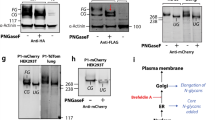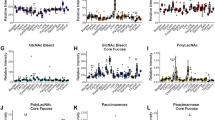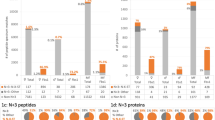Abstract
NGLY1 deficiency is a rare autosomal recessive genetic disorder caused by biallelic mutations of the human NGLY1 gene. NGLY1 encodes the cytosolic peptide:N-glycanase (PNGase; NGLY1 in mammals), which plays essential roles in cytosolic glycan degradation (non-lysosomal glycan degradation), the endoplasmic reticulum (ER)-associated degradation (ERAD) of misfolded proteins, and the complete activation of the transcription factor nuclear factor erythroid 2-like 1 (NEF2L1). NFE2L1 contributes to the regulation of the expression of proteasome subunits and oxidative stress responses. Patients with NGLY1 deficiency exhibit multisystemic clinical features, including global developmental delay, peripheral neuropathy, hypolacrima or alacrima, and the transient elevation of liver transaminases. To date, more than 100 individuals with NGLY1 deficiency and over 70 distinct pathogenic mutations in the NGLY1 gene have been reported. There is currently no approved therapy for this disorder. Moreover, the underlying pathogenic mechanism, including the correlation between patients’ symptoms and mutant alleles, remains poorly understood. In this review, we summarize the most frequently reported NGLY1 mutations and their associated clinical features. We also present an overview of the current therapeutic strategy for NGLY1 deficiency.
This is a preview of subscription content, access via your institution
Access options
Subscribe to this journal
Receive 12 print issues and online access
$259.00 per year
only $21.58 per issue
Buy this article
- Purchase on SpringerLink
- Instant access to full article PDF
Prices may be subject to local taxes which are calculated during checkout


Similar content being viewed by others

References
Suzuki T. Catabolism of N-glycoproteins in mammalian cells: molecular mechanisms and genetic disorders related to the processes. Mol Asp Med. 2016;51:89–103.
Lehrbach NJ, Breen PC, Ruvkun G. Protein sequence editing of SKN-1A/Nrf1 by peptide:N-glycanase controls proteasome gene expression. Cell. 2019;177:737–50.e15.
Kim HM, Han JW, Chan JY. Nuclear factor erythroid-2 like 1 (NFE2L1): structure, function and regulation. Gene. 2016;584:17–25.
Suzuki T, Park H, Hollingsworth NM, Sternglanz R, Lennarz WJ. PNG1, a yeast gene encoding a highly conserved peptide:N-glycanase. J Cell Biol. 2000;149:1039–52.
Serafini-Fracassini D, Della Mea M, Parrotta L, Faleri C, Cai G, Del Duca S, et al. AtPng1 knockout mutant of Arabidopsis thaliana shows a juvenile phenotype, morpho-functional changes, altered stress response and cell wall modifications. Plant Physiol Biochem. 2021;167:11–21.
Maerz S, Funakoshi Y, Negishi Y, Suzuki T, Seiler S. The Neurospora peptide:N-glycanase ortholog PNG1 is essential for cell polarity despite its lack of enzymatic activity. J Biol Chem. 2010;285:2326–32.
Seiler S, Plamann M. The genetic basis of cellular morphogenesis in the filamentous fungus Neurospora crassa. Mol Biol Cell. 2003;14:4352–64.
Habibi-Babadi N, Su A, de Carvalho CE, Colavita A. The N-glycanase png-1 acts to limit axon branching during organ formation in Caenorhabditis elegans. J Neurosci. 2010;30:1766–76.
Kong J, Peng M, Ostrovsky J, Kwon YJ, Oretsky O, McCormick EM, et al. Mitochondrial function requires NGLY1. Mitochondrion. 2018;38:6–16.
Lehrbach NJ, Ruvkun G. Endoplasmic reticulum-associated SKN-1A/Nrf1 mediates a cytoplasmic unfolded protein response and promotes longevity. Elife. 2019;8:e44425.
Iyer S, Mast JD, Tsang H, Rodriguez TP, DiPrimio N, Prangley M, et al. Drug screens of NGLY1 deficiency in worm and fly models reveal catecholamine, NRF2 and anti-inflammatory-pathway activation as potential clinical approaches. Dis Model Mech. 2019;12:dmm040576.
Lehrbach NJ, Ruvkun G. Proteasome dysfunction triggers activation of SKN-1A/Nrf1 by the aspartic protease DDI-1. Elife. 2016;5:e17721.
Yanagi KS, Jochim B, Kunjo SO, Breen P, Ruvkun G, Lehrbach N. Mutations in nucleotide metabolism genes bypass proteasome defects in png-1/NGLY1-deficient Caenorhabditis elegans. PLoS Biol. 2024;22:e3002720.
Funakoshi Y, Negishi Y, Gergen JP, Seino J, Ishii K, Lennarz WJ, et al. Evidence for an essential deglycosylation-independent activity of PNGase in Drosophila melanogaster. PLoS One. 2010;5:e10545.
Galeone A, Adams JM, Matsuda S, Presa MF, Pandey A, Han SY, et al. Tissue-specific regulation of BMP signaling by Drosophila N-glycanase 1. Elife. 2017;6:e27612.
Han SY, Pandey A, Moore T, Galeone A, Duraine L, Cowan TM, et al. A conserved role for AMP-activated protein kinase in NGLY1 deficiency. PLoS Genet. 2020;16:e1009258.
Pandey A, Galeone A, Han SY, Story BA, Consonni G, Mueller WF, et al. Gut barrier defects, intestinal immune hyperactivation and enhanced lipid catabolism drive lethality in NGLY1-deficient Drosophila. Nat Commun. 2023;14:5667.
Galeone A, Adams JM, Matsuda S, Presa MF, Pandey A, Han SY, et al. Regulation of BMP4/Dpp retrotranslocation and signaling by deglycosylation. Elife. 2020;9:e55596.
Pandey A, Jafar-Nejad H. Tracing the NGLY1 footprints: insights from Drosophila. J Biochem. 2022;171:153–60.
Fujihira H, Masahara-Negishi Y, Tamura M, Huang C, Harada Y, Wakana S, et al. Lethality of mice bearing a knockout of the Ngly1-gene is partially rescued by the additional deletion of the Engase gene. PLoS Genet. 2017;13:e1006696.
Asahina M, Fujinawa R, Fujihira H, Masahara-Negishi Y, Andou T, Tozawa R, et al. JF1/B6F1 Ngly1(-/-) mouse as an isogenic animal model of NGLY1 deficiency. Proc Jpn Acad Ser B Phys Biol Sci. 2021;97:89–102.
Need AC, Shashi V, Hitomi Y, Schoch K, Shianna KV, McDonald MT, et al. Clinical application of exome sequencing in undiagnosed genetic conditions. J Med Genet. 2012;49:353–61.
Abuduxikuer K, Zou L, Wang L, Chen L, Wang JS. Novel NGLY1 gene variants in Chinese children with global developmental delay, microcephaly, hypotonia, hypertransaminasemia, alacrimia, and feeding difficulty. J Hum Genet. 2020;65:387–96.
Bosch DG, Boonstra FN, de Leeuw N, Pfundt R, Nillesen WM, de Ligt J, et al. Novel genetic causes for cerebral visual impairment. Eur J Hum Genet. 2016;24:660–5.
Caglayan AO, Comu S, Baranoski JF, Parman Y, Kaymakçalan H, Akgumus GT, et al. NGLY1 mutation causes neuromotor impairment, intellectual disability, and neuropathy. Eur J Med Genet. 2015;58:39–43.
Chang CA, Wei XC, Martin SR, Sinasac DS, Al-Hertani W. Transiently elevated plasma methionine, S-adenosylmethionine and S-adenosylhomocysteine: unreported laboratory findings in a patient with NGLY1 deficiency, a congenital disorder of deglycosylation. JIMD Rep. 2019;49:21–29.
Dabaj I, Sudrié-Arnaud B, Lecoquierre F, Raymond K, Ducatez F, Guerrot AM, et al. NGLY1 deficiency: a rare newly described condition with a typical presentation. Life. 2021;11:187.
Enns GM, Shashi V, Bainbridge M, Gambello MJ, Zahir FR, Bast T, et al. Mutations in NGLY1 cause an inherited disorder of the endoplasmic reticulum-associated degradation pathway. Genet Med. 2014;16:751–8.
Frater CH, Ruzhnikov M, Beres S, Alcorn D, Shue A, Levy RJ. Ocular features of NGLY1 deficiency from a prospective longitudinal cohort. J AAPOS. 2024;28:103925.
Ge H, Wu Q, Lu H, Huang Y, Zhou T, Tan D, et al. Two novel compound heterozygous mutations in NGLY1as a cause of congenital disorder of deglycosylation: a case presentation. BMC Med Genet. 2020;21:135.
Heeley J, Shinawi M. Multi-systemic involvement in NGLY1-related disorder caused by two novel mutations. Am J Med Genet A. 2015;167A:816–20.
Kalfon L, Baydany M, Samra N, Heno N, Segal Z, Eran A, et al. Congenital hypotonia: cracking a SAGA of consanguineous kindred harboring four genetic variants. Mol Genet Genom Med. 2022;10:e1849.
Kariminejad A, Shakiba M, Shams M, Namiranian P, Eghbali M, Talebi S, et al. NGLY1 deficiency: novel variants and literature review. Eur J Med Genet. 2021;64:104146.
Lam C, Ferreira C, Krasnewich D, Toro C, Latham L, Zein WM, et al. Prospective phenotyping of NGLY1-CDDG, the first congenital disorder of deglycosylation. Genet Med. 2017;19:160–8.
Levy RJ, Frater CH, Gallentine WB, Phillips JM, Ruzhnikov MR. Delineating the epilepsy phenotype of NGLY1 deficiency. J Inherit Metab Dis. 2022;45:571–83.
Lipari Pinto P, Machado C, Janeiro P, Dupont J, Quintas S, Sousa AB, et al. NGLY1 deficiency-A rare congenital disorder of deglycosylation. JIMD Rep. 2020;53:2–9.
Lipiński P, Bogdańska A, Różdżyńska-Świątkowska A, Wierzbicka-Rucińska A, Tylki-Szymańska A. NGLY1 deficiency: Novel patient, review of the literature and diagnostic algorithm. JIMD Rep. 2020;51:82–88.
Lipiński P, Bogdańska A, Socha P, Tylki-Szymańska A. Liver involvement in congenital disorders of glycosylation and deglycosylation. Front Pediatr. 2021;9:696918.
Lipiński P, Cielecka-Kuszyk J, Socha P, Tylki-Szymańska A. Liver involvement in NGLY1 congenital disorder of deglycosylation. Pol J Pathol. 2020;71:66–68.
Nolan DK, Pastore MT, McBride KL. Expanding the NGLY1 deficiency phenotype: case report of an atypical patient. Eur J Med Genet. 2022;65:104558.
Pandey A, Adams JM, Han SY, Jafar-Nejad H. NGLY1 deficiency, a congenital disorder of deglycosylation: from disease gene function to pathophysiology. Cells. 2022;11:1155.
Panneman DM, Wortmann SB, Haaxma CA, van Hasselt PM, Wolf NI, Hendriks Y, et al. Variants in NGLY1 lead to intellectual disability, myoclonus epilepsy, sensorimotor axonal polyneuropathy and mitochondrial dysfunction. Clin Genet. 2020;97:556–66.
Rios-Flores IM, Bonal-Pérez MÁ, Castellanos-González A, Velez-Gómez E, Bertoli-Avella AM, Bobadilla-Morales L, et al. Acute liver failure in a male patient with NGLY1-congenital disorder of deglycosylation. Eur J Med Genet. 2020;63:103952.
Sonoda Y, Fujita A, Torio M, Mukaino T, Sakata A, Matsukura M, et al. Progressive myoclonic epilepsy as an expanding phenotype of NGLY1-associated congenital deglycosylation disorder: a case report and review of the literature. Eur J Med Genet. 2024;67:104895.
Stanclift CR, Dwight SS, Lee K, Eijkenboom QL, Wilsey M, Wilsey K, et al. NGLY1 deficiency: estimated incidence, clinical features, and genotypic spectrum from the NGLY1 Registry. Orphanet J Rare Dis. 2022;17:440.
Stuut T, Popescu O, Oviedo A. N-Glycanase 1 deficiency is a rare cause of pediatric neurodegeneration with neuronal inclusions and liver steatosis. Cureus. 2021;13:e19126.
Tong S, Ventola P, Frater CH, Klotz J, Phillips JM, Muppidi S, et al. NGLY1 deficiency: a prospective natural history study. Hum Mol Genet. 2023;32:2787–96.
Ullah A, Shah AA, Alluqmani M, Haider N, Aman H, Alfadhli F, et al. Clinical and genetic characterization of patients segregating variants in KPTN, MINPP1, NGLY1, AP4B1, and SON underlying neurodevelopmental disorders: genetic and phenotypic expansion. Int J Dev Neurosci. 2022;82:789–805.
van Keulen BJ, Rotteveel J, Finken MJJ. Unexplained death in patients with NGLY1 mutations may be explained by adrenal insufficiency. Physiol Rep. 2019;7:e13979.
Zidoune H, Martinerie L, Tan DS, Askari M, Rezgoune D, Ladjouze A, et al. Expanding DSD phenotypes associated with variants in the DEAH-Box RNA helicase DHX37. Sex Dev. 2021;15:244–52.
Hirayama H, Tachida Y, Seino J, Suzuki T. A method for assaying peptide: N-glycanase/N-glycanase 1 activities in crude extracts using an N-glycosylated cyclopeptide. Glycobiology. 2022;32:110–22.
Fujihira H, Sato K, Nishiuchi Y, Murase T, Matsuda Y, Yoshida Y, et al. ELISA-based highly sensitive assay system for the detection of endogenous NGLY1 activity. Biochem Biophys Res Commun. 2024;710:149826.
Achouitar S, Mohamed M, Gardeitchik T, Wortmann SB, Sykut-Cegielska J, Ensenauer R, et al. Nijmegen paediatric CDG rating scale: a novel tool to assess disease progression. J Inherit Metab Dis. 2011;34:923–7.
Melnyk S, Pogribna M, Pogribny IP, Yi P, James SJ. Measurement of plasma and intracellular S-adenosylmethionine and S-adenosylhomocysteine utilizing coulometric electrochemical detection: alterations with plasma homocysteine and pyridoxal 5’-phosphate concentrations. Clin Chem. 2000;46:265–72.
Asahina M, Fujinawa R, Hirayama H, Tozawa R, Kajii Y, Suzuki T. Reversibility of motor dysfunction in the rat model of NGLY1 deficiency. Mol Brain. 2021;14:91.
Zhu L, Tan B, Dwight SS, Beahm B, Wilsey M, Crawford BE, et al. AAV9-NGLY1 gene replacement therapy improves phenotypic and biomarker endpoints in a rat model of NGLY1 Deficiency. Mol Ther Methods Clin Dev. 2022;27:259–71.
Du A, Yang K, Zhou X, Ren L, Liu N, Zhou C, et al. Systemic gene therapy corrects neurological phenotype in a mouse model of NGLY1 deficiency. JCI Insight. 2024;9:e183189.
Chan KY, Jang MJ, Yoo BB, Greenbaum A, Ravi N, Wu WL, et al. Engineered AAVs for efficient noninvasive gene delivery to the central and peripheral nervous systems. Nat Neurosci. 2017;20:1172–9.
Froemke RC, Young LJ. Oxytocin, neural plasticity, and social behavior. Annu Rev Neurosci. 2021;44:359–81.
Makita Y, Asahina M, Fujinawa R, Yukitake H, Suzuki T. Intranasal oxytocin suppresses seizure-like behaviors in a mouse model of NGLY1 deficiency. Commun Biol. 2024;7:460.
Hope KA, Berman AR, Peterson RT, Chow CY. An in vivo drug repurposing screen and transcriptional analyses reveals the serotonin pathway and GSK3 as major therapeutic targets for NGLY1 deficiency. PLoS Genet. 2022;18:e1010228.
Rodriguez TP, Mast JD, Hartl T, Lee T, Sand P, Perlstein EO. Defects in the neuroendocrine axis contribute to global development delay in a drosophila model of NGLY1 deficiency. G3 Bethesda. 2018;8:2193–204.
Yoshida Y, Asahina M, Murakami A, Kawawaki J, Yoshida M, Fujinawa R, et al. Loss of peptide:N-glycanase causes proteasome dysfunction mediated by a sugar-recognizing ubiquitin ligase. Proc Natl Acad Sci USA. 2021;118:e2102902118.
Satoh T, Yagi-Utsumi M, Ishii N, Mizushima T, Yagi H, Kato R, et al. Structural basis of sugar recognition by SCF(FBS2) ubiquitin ligase involved in NGLY1 deficiency. FEBS Lett. 2024;598:2259–68.
Yoshida Y, Tokunaga F, Chiba T, Iwai K, Tanaka K, Tai T. Fbs2 is a new member of the E3 ubiquitin ligase family that recognizes sugar chains. J Biol Chem. 2003;278:43877–84.
Yoshida Y, Takahashi T, Ishii N, Matsuo I, Takahashi S, Inoue H, et al. Sugar-mediated non-canonical ubiquitination impairs Nrf1/NFE2L1 activation. Mol Cell. 2024;84:3115–27.
Haijes HA, de Sain-van der Velden M, Prinsen H, Willems AP, van der Ham M, Gerrits J, et al. Aspartylglycosamine is a biomarker for NGLY1-CDDG, a congenital disorder of deglycosylation. Mol Genet Metab. 2019;127:368–72.
Acknowledgements
We wish to thank the members of the Glycometabolic Biochemistry Laboratory (RIKEN) for their fruitful discussion.
Funding
This work was supported by the Japan Agency for Medical Research and Development-Core Research for Evolutional Science and Technology (AMED-CREST, JP25gm14100003) (to TS and HF).
Author information
Authors and Affiliations
Corresponding authors
Ethics declarations
Competing interests
The authors declare no competing interests.
Additional information
Publisher’s note Springer Nature remains neutral with regard to jurisdictional claims in published maps and institutional affiliations.
Rights and permissions
Springer Nature or its licensor (e.g. a society or other partner) holds exclusive rights to this article under a publishing agreement with the author(s) or other rightsholder(s); author self-archiving of the accepted manuscript version of this article is solely governed by the terms of such publishing agreement and applicable law.
About this article
Cite this article
Fujihria, H., Hirayama, H. & Suzuki, T. NGLY1 deficiency - clinical features and therapeutic strategy. J Hum Genet (2025). https://doi.org/10.1038/s10038-025-01376-4
Received:
Revised:
Accepted:
Published:
DOI: https://doi.org/10.1038/s10038-025-01376-4


